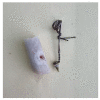Extracorporeal Shock Wave Therapy as a Helpful Method for Rapid Osseointegration of Dental Implants: Animal Study
- PMID: 37092389
- PMCID: PMC10123648
- DOI: 10.3390/biomimetics8020137
Extracorporeal Shock Wave Therapy as a Helpful Method for Rapid Osseointegration of Dental Implants: Animal Study
Abstract
The aim of this study was to assess the multi-phasic use of extracorporeal shock wave therapy (ESWT) as an adjuvant treatment to accelerate the osseointegration of titanium dental implants. Initially, twelve titanium mini-screws were inserted in femur bones of six New Zealand rabbits in three groups; the one-time treated group, the three-time treated group, and the control group (without ESWT). Then, 1800 focused shockwaves with an energy flux density of 0.3 mJ/mm2 in every phase were used. Fourteen days after the last phase of ESWT, the animals were sacrificed to assess the osseointegration of screws via micro-computed tomography scan (micro-CT scan), biomechanical pull-out test, and histopathological analysis. Pull-out and histopathology analysis showed that the ESWT significantly increased bone regeneration and osseointegration around the implants compared to the control group (p < 0.05). Moreover, the pull-out test confirmed that the three-time treated screws needed more force to pull the bone out compared to the other two groups (p < 0.05). The mean bone volume fraction between the control group, the one-time treated group, and the three-time treatment group were not statistically significant (p > 0.05) according to the micro-CT scan results. Based on our results, ESWT can be suggested as a non-invasive and cost-effective adjuvant for osseointegration of dental implants. However, more in vivo studies and clinical trials are needed for validation of this finding.
Keywords: bone regeneration; bone volume fraction; dental implants; extracorporeal shockwave therapy; osseointegration.
Conflict of interest statement
The authors declare no conflict of interest.
Figures




Similar articles
-
Extracorporeal shock wave therapy (ESWT) may be helpful in the osseointegration of dental implants: A hypothesis.Med Hypotheses. 2020 Dec;145:110294. doi: 10.1016/j.mehy.2020.110294. Epub 2020 Sep 22. Med Hypotheses. 2020. PMID: 33032172
-
Histomorphometric and biomechanical evaluation of the osseointegration around micro- and nano-level boron-nitride coated titanium dental implants.J Stomatol Oral Maxillofac Surg. 2022 Nov;123(6):e694-e700. doi: 10.1016/j.jormas.2022.06.016. Epub 2022 Jun 18. J Stomatol Oral Maxillofac Surg. 2022. PMID: 35724866
-
The effect of low-intensity pulsed ultrasound on the osseointegration of titanium dental implants.Br J Oral Maxillofac Surg. 2012 Apr;50(3):244-50. doi: 10.1016/j.bjoms.2011.03.001. Epub 2011 Apr 3. Br J Oral Maxillofac Surg. 2012. PMID: 21459497
-
Parathyroid hormone enhances gap healing and osseointegration in orthopedic porous coated titanium implants: a correlative micro-computed tomographic, histomorphometric and biomechanical analysis.BMC Musculoskelet Disord. 2022 Jan 3;23(1):17. doi: 10.1186/s12891-021-04917-y. BMC Musculoskelet Disord. 2022. PMID: 34980060 Free PMC article.
-
In vivo osseointegration of dental implants with an antimicrobial peptide coating.J Mater Sci Mater Med. 2017 May;28(5):76. doi: 10.1007/s10856-017-5885-8. Epub 2017 Apr 6. J Mater Sci Mater Med. 2017. PMID: 28386851
Cited by
-
Mandibular Overdenture Supported by Two or Four Unsplinted or Two Splinted Ti-Zr Mini-Implants: In Vitro Study of Peri-Implant and Edentulous Area Strains.Biomimetics (Basel). 2024 Mar 15;9(3):178. doi: 10.3390/biomimetics9030178. Biomimetics (Basel). 2024. PMID: 38534864 Free PMC article.
-
Correlation between vitamin D3 serum levels and jaw bone density of candidates for dental implant treatment using CBCT.J Dent Res Dent Clin Dent Prospects. 2025 Mar 31;19(1):40-45. doi: 10.34172/joddd.025.41648. eCollection 2025 Mar. J Dent Res Dent Clin Dent Prospects. 2025. PMID: 40464023 Free PMC article.
-
Biomechanics of Osseointegration of a Dental Implant in the Mandible Under Shock Wave Therapy: In Silico Study.Materials (Basel). 2024 Dec 19;17(24):6204. doi: 10.3390/ma17246204. Materials (Basel). 2024. PMID: 39769804 Free PMC article.
References
Grants and funding
LinkOut - more resources
Full Text Sources

